Your cart is currently empty!
Comparison of Different Types of Wooden Cutting Boards: Teak vs Mango vs Tamarind
In a kitchen, the chopping board is one accessory which is used daily. Most home cooks cannot do without a kitchen cutting board. With that said, the varieties of cutting boards are wide, making a decision a horrendous task. In wood, there are more than 10 varieties which are commonly used. In India, there are 3 varieties which are very common in households: Mango wood, Teak, and Tamarind. This article compares the benefits of each of these cutting boards and where they excel and where they fail.
What to Look for in a Wooden Cutting Board
Before we begin, let’s understand the basic requirements people look for in a wooden cutting board. Not everyone is looking for the same wooden cutting board. Some of us are looking for a beautiful board for its aesthetics. Some are looking for a board that is durable. Professional chefs will look for a board that is knife friendly. Most young chefs who cook once in a while look for a board that is affordable and easy to maintain. Some of us are eco-conscious and looking for a sustainable wooden board. Well, every single person looking for a wooden cutting board is looking for something specific. And wooden boards offer them just that. A good wooden cutting board is often durable but depends on the quality of the wood. Durability of some woods is more than the other. Maintenance of wood with pest resistance and low porosity is easy while those which are lighter are often hard to maintain. Some woods which are oily are known to resist moisture and are free from mould, while those with poor natural oil content are prone to mould and fungal growth if not maintained well.
So, before you get to choose the right board, understand the type of wood, how to identify them and their pros and cons. It’s important that you choose the board which is perfect for your kitchen, lifestyle and location!
Teak Cutting Boards.
Teak wood cutting boards fall under the luxury category of cutting boards. They are expensive, beautiful, durable and food-safe. The properties of teak wood, the rich oil content in the wood and the beauty make it the preferred choice for cutting boards. They are antibacterial, have a tight grain which makes them resistant to moisture. The oil content also repels water naturally. Used in boat construction, teak wood is very durable. Widely used for construction, furniture and more, teak is tough, beautiful and stands the test of time. For a cutting board, the wood makes it perfect as a piece of art in your kitchen.
Pros of Teak wood cutting boards
Teak wood cutting boards are known to be naturally resistant to moisture content. Kitchen cutting boards go through regular washing, making most woods prone to rot, fungal and mould infestations and rapid deterioration. Teak wood, on the other hand, is very durable. They don’t get soaked easily due to their natural oil content. Also, the oil content in the wood ensures that bacterial build-up is killed almost immediately. They are tough to scratch through making them perfect again for cutting boards. Knife marks rarely get through and when it does, it’s months and years. They are easily reclaimed and repurposed. You can use them as a tray or just resurface it and keep using it again for years. Most teak wood boards last decades, not years. When it comes to maintenance too, teak wood tops the list. They are easy to maintain. You forget to oil it one week? No problem. The board works perfectly well and without a problem. They don’t split, crack or warp easily.
Cons and drawbacks of Teak wood cutting boards
Teak wood cutting boards are expensive. The wood costs ₹4500 on average for a cubic foot. That is just the cost of the wood. So don’t be amazed to see a cutting board costing ₹1500, ₹2000 or even ₹5000. Single wood cutting boards made from teak are extremely rare and when you do find them, expect to pay a premium price.
The other drawback, which most professional chefs will face, is that they dull knives. An edge grain cutting board made from teak wood has this problem, but not an end grain. So if you are a professional chef looking for a premium teak wood cutting board, go for end grain cutting boards.
Ideal for: The edge grain boards are best for home kitchens. The end grain is good for professional chefs and commercial kitchens. Teak wood boards are perfect for people who cook meat. Due to its antibacterial features, rich oil content and durability, they make it the perfect board for cutting meat, fish, and poultry.
Mango Wood Cutting Boards

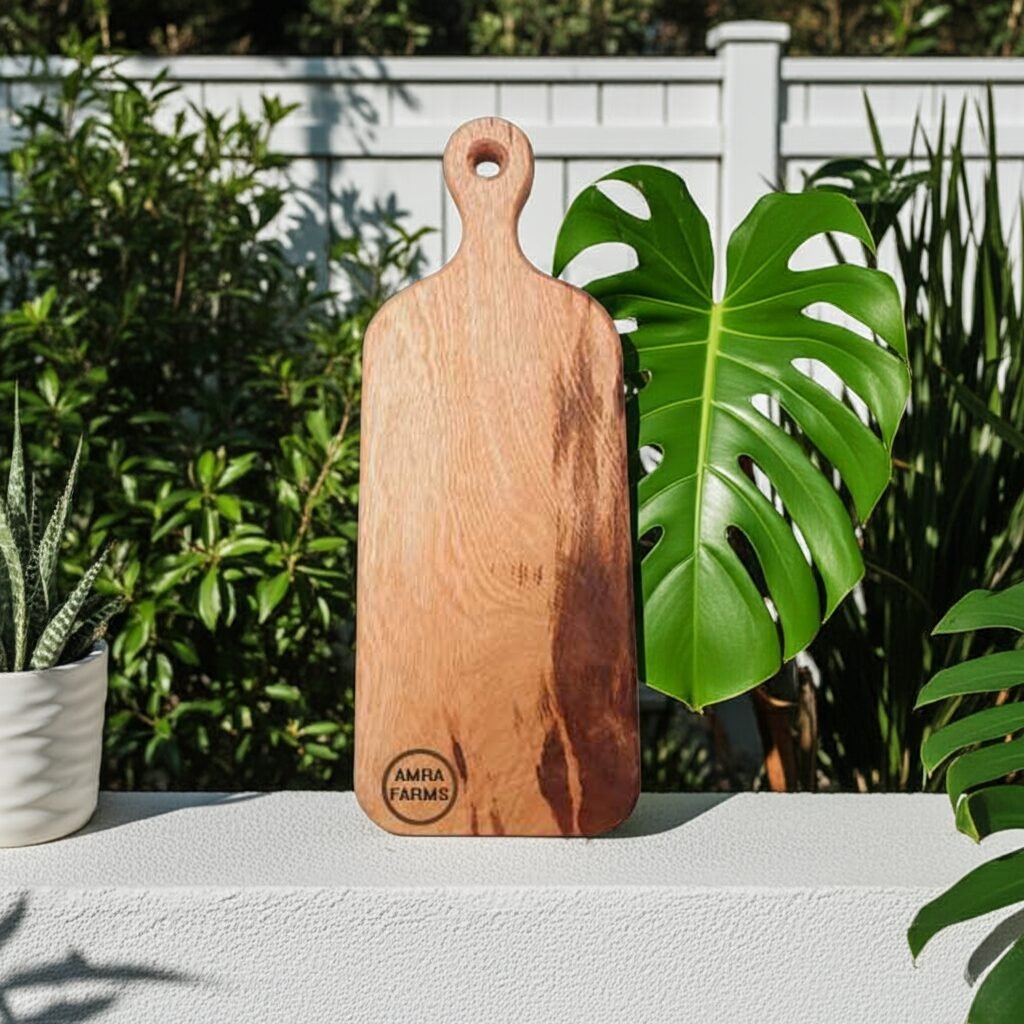
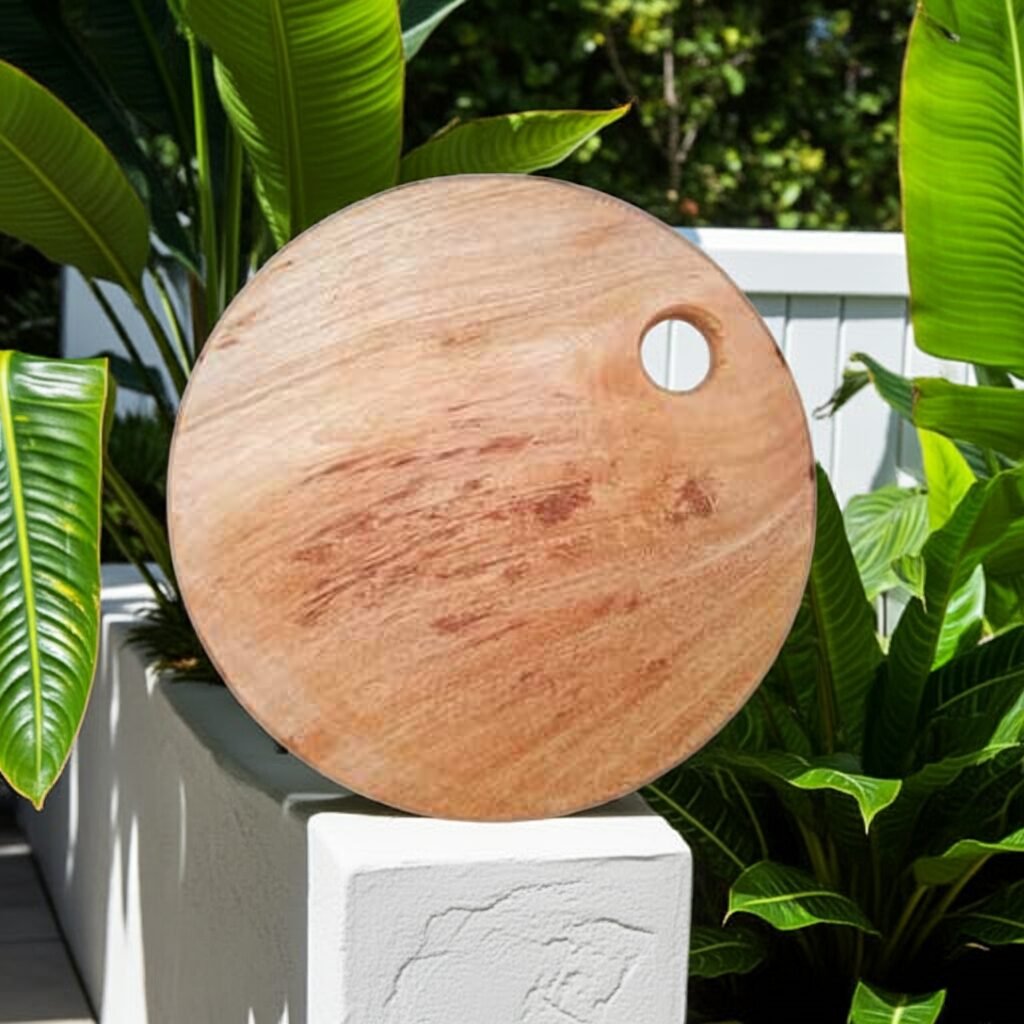
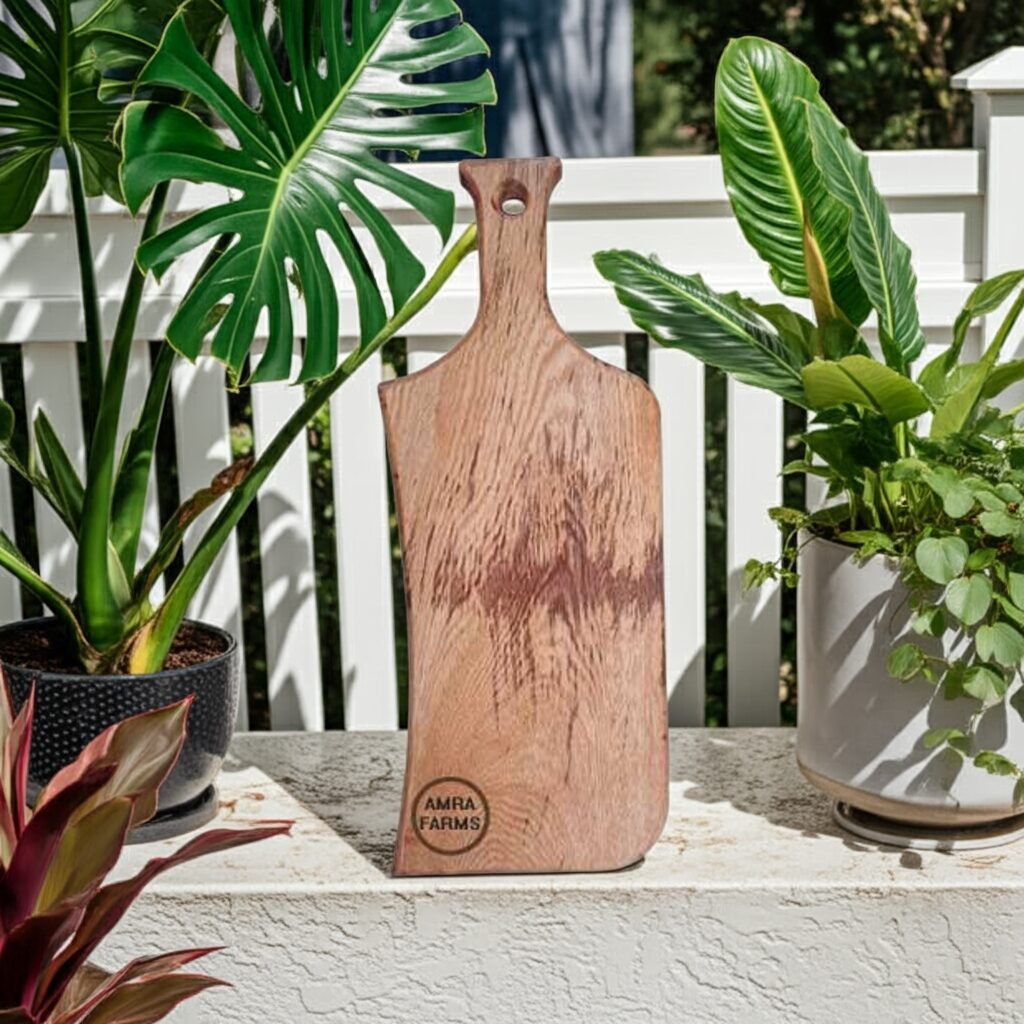

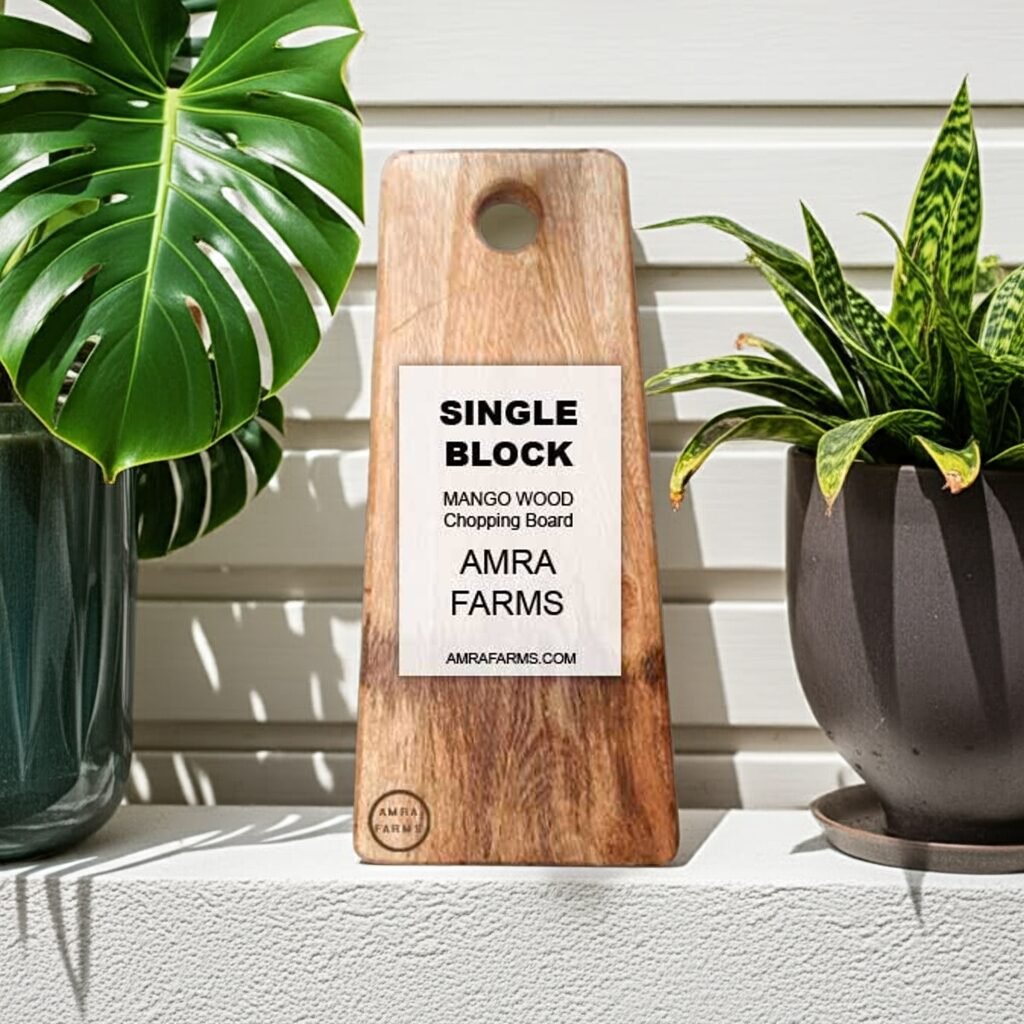
Mango wood chopping boards are great for those who love the rustic look. A beautiful wood which has peculiar grains with a wide range of patterns, mango wood is a beauty which most artisans love. They are durable, light, and they tend to darken over time so don’t worry if your board looks yellow and pale in the beginning. They turn brown with darker grains over time. A mango wooden board used over a year will show a stark difference from the one you purchased. The grains will be more prominent and almost impossible to recognise in terms of its grains and beauty.
Mango wood is eco-friendly. Most mango trees are cut after a certain age. These woods are usually burnt and used in construction sites. They are rarely converted to furniture. Brick kilns are the biggest customers for mango wood. They burn this wood to make bricks and tiles. Fortunately, mango wood now has a purpose. They are budget friendly and often cost a bit more than a plastic board or a glass cutting board of the same size. Bigger boards made from single wood may cost a bit more, often double the price of joined wood.
Pros of Mango wood cutting boards
Mango wood is a sustainable source and environment friendly. Most of the wood comes from old trees as new and productive mango trees are rarely cut. They are budget friendly, not very expensive and aesthetically appealing. Their rustic looks add to the charm. They are perfect if you love the grungy look or the farmhouse-styled chopping boards. Interestingly, mango wood is also light. They are easy to carry, unlike teak wood boards which are heavy.
Drawbacks of Mango wood cutting boards
Mango wood cutting boards are sensitive to moisture. If you live in an area where moisture is high, you need to ensure the boards are really dry after use. There could be problems due to mould and fungus in moist areas, especially if the board is left moist. They are softer than teak wood, which is good if you are looking for a knife-friendly board, but then it also affects the durability of the wood. Knife scratches start to appear in a few months and you should resurface the boards with sandpaper once every 6 months. This increases maintenance of the wood too. You should oil the boards regularly without fail. Oil them once a week and your board will last 4–5 years.
Ideal for: The mango wood chopping board is best for cutting vegetables. If you are one of those who want to cut meat, we advise you to keep away from this board. If you are looking for a budget-friendly board, the mango wood is the perfect option. They are cost-effective and safe for use.
Tamarind Wood Cutting Boards
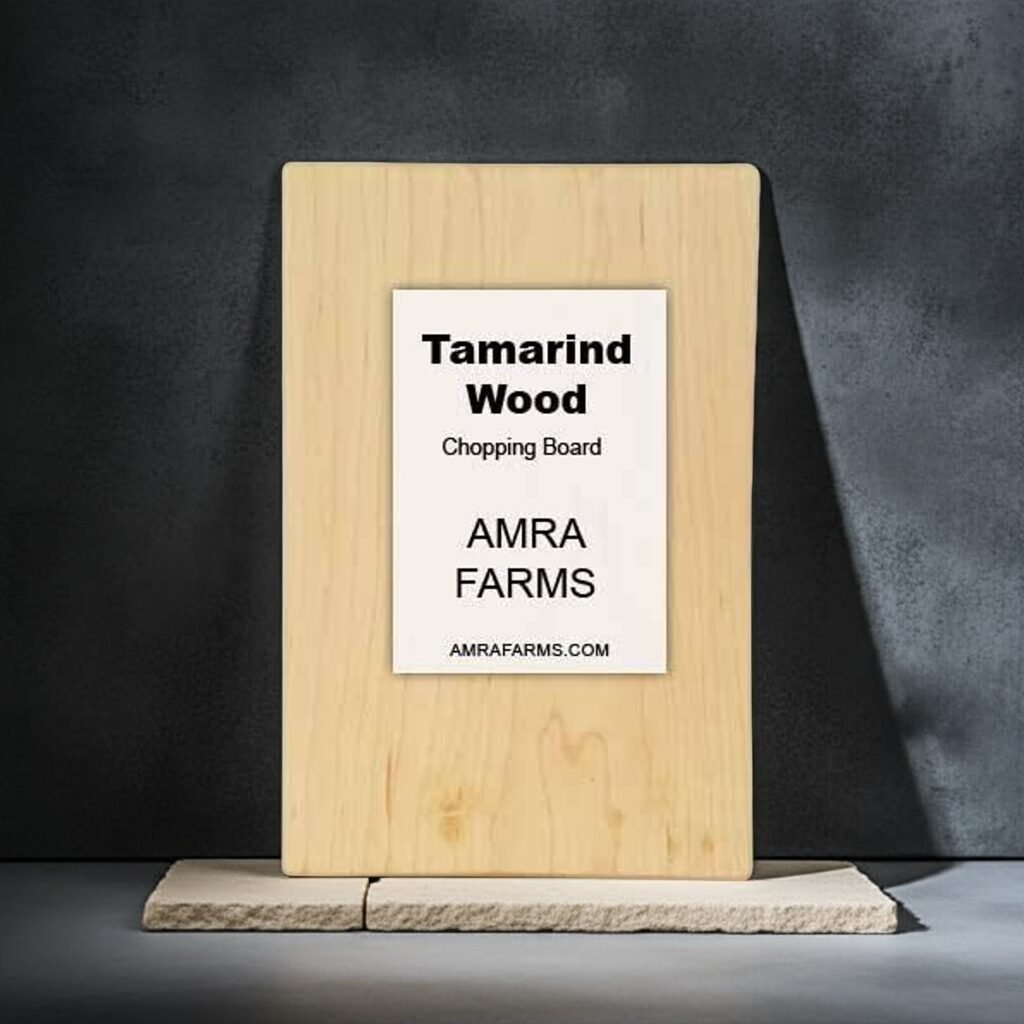
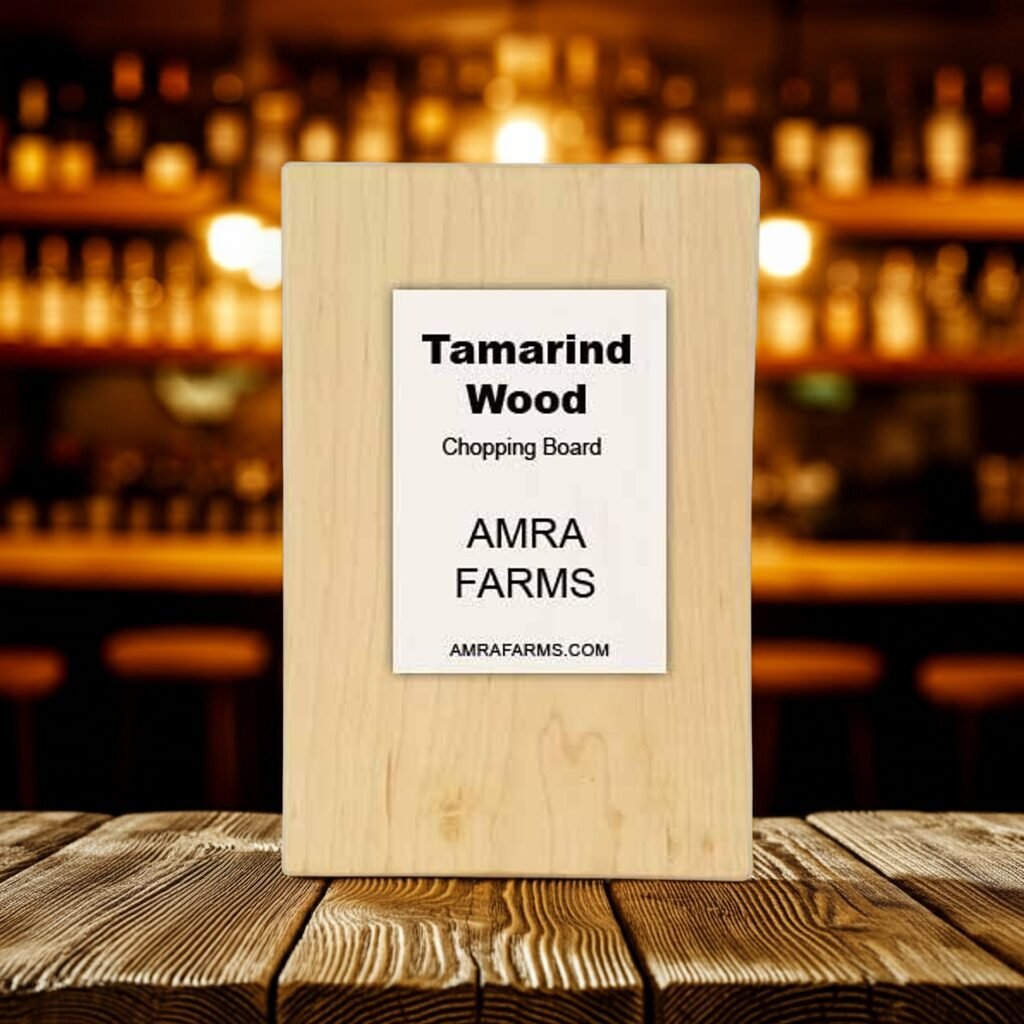

Tamarind wood is the most interesting wood which is very underrated. Tamarind wood is not as beautiful as most of the other woods in the list, at least not initially, but there is this peculiar beauty and grain of tamarind wood which makes it interesting. The tamarind wood, which is affected by fungal growth, features a dark intricate pattern, which is often referred to as spalted wood. These tamarind woods are prized and are expensive. They have criss-cross interlocked grain structure which makes it resistant to cracking and splitting. This ensures the wood is durable and resistant to deep cuts.
Tamarind wood has been used for ages in South India as a cutting board but recent years have seen changes and with the penetration of bamboo, plastic and steel boards, tamarind wood slowly faded away from homes. Very few people make tamarind wood cutting boards and one of the prominent ones is ChefBae.
Tamarind woods are relatively rare and available mostly in the southern part of India. The northern part of India does not have these trees as they are not commercially grown and the fruit is rarely consumed in the north. Tamil Nadu is the biggest producer of tamarind and the roads are lined with tamarind trees in many parts of Tamil Nadu. Kerala is abundant with tamarind trees too, but they are not commercially cultivated.
Pros of Tamarind wooden boards
Tamarind wood is known for its unique grain pattern, especially when you find the spalted wood. These are beautiful and rare too. They are known for their artisanal value and are perfect for gifting as they are display-worthy. The wood is dense and sturdy—this makes it perfect for use as a cutting board. They are durable, require moderate maintenance and are rugged.
Cons of Tamarind wooden cutting boards
The only downside to a cutting board is the weight. They are heavier than mango wood but lighter than teak. They are not as expensive as teak but more than mango wood. It’s not the type of wood that is appealing to everyone though.
Ideal for: Meat cutting. They are the preferred wooden material to cut meat. They are safe, antibacterial and resist cuts. As they are dense, they do not cut and scratch easily, making it a perfect wooden chopping board for chopping meat, fish and poultry. When using specifically to cut meat, opt for an end grain tamarind chopping board.
Final Verdict
Teak wood: Choose the teak wood if you are willing to spend more, want the aesthetics and a tough board which can handle all tasks. They are antibacterial and food safe. Low maintenance.
Mango wood: Choose a mango wood chopping board if you are more into cutting vegetables and on a budget. Do not opt for these boards for meat. If you are not the kind who takes the time to maintain the board, then mango wood is not for you.
Tamarind wood cutting boards: They are perfect for chopping meat and are durable. Relatively mid-range and require moderate care.
Categories
Products
- Buy Wooden Vegetable Cutting Boards Online
- Wooden Kitchen Accessories Tools
- Buy Butcher Block & Meat Cutting Boards Online
- Buy Premium Edge Grain Single Block Wooden Chopping Boards Online
- Buy The Best Teak Wood Chopping Boards Online In India
- Buy Wooden Cutting Boards With Handle For Kitchen
- Mango Wood Chopping Boards
- Single Block Chopping Boards
- Tamarind Wood Chopping Boards
- Wooden Platter Boards , Pizza Platters & Charcuterie Boards
Tamarind Wood Cutting Board Teak Wood Cutting board
